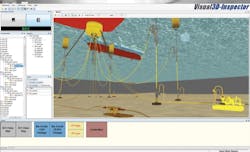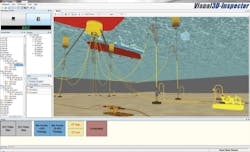Reviewing the world offshore rig market
Matthew Donovan
Marine Market Analyst
ODS-Petrodata
The worldwide offshore rig market continues to suffer from oversupply as new rig deliveries outstrip demand. As new rigs built to ever-higher specifications are delivered, older rigs have more trouble securing contracts.
The number of mobile offshore drilling units under contract worldwide is currently 572, almost identical to the number of rigs under contract at this time last year. However, there are now 790 rigs in the worldwide drilling fleet, compared to the 749 in existence in January 2010. With the increase in fleet size, worldwide offshore rig utilization is now 72.4%, down from 76.5% a year ago.
According to ODS-Petrodata’s RigBase market intelligence tool, 104 mobile offshore drilling rigs are under construction or on order around the world, with 57 of these rigs scheduled for delivery this year. Only 30 of the rigs set for delivery this year have contracts lined up.
Gulf of Mexico
The Macondo disaster and its aftereffects proved anannus horribilis for the U.S. Gulf of Mexico. From the perspective of the offshore industry, a federally imposed moratorium on deepwater drilling halted the issuing of new deepwater permits. Even with the moratorium now officially over, the Bureau of Ocean Energy Management, Regulation, and Enforcement has not been forthcoming with new deepwater permits, and regulatory changes have resulted in a sharp reduction in the number of shallow water permits issued. This has done additional damage to the shallow water rig market, which had just been showing signs of revival after being battered by low commodity prices and general economic malaise in 2009.
Offshore rig fleet utilization in the U.S. Gulf is now 47.6%, down from an already-anemic 55.9% utilization rate in January 2010. Of the 126 rigs in the region, 60 are under contract. Jackup utilization is only 37.3%, while semisubmersible utilization languishes at 69.2%, down from 100% a year ago. Drillship utilization has remained 100%, and, although only three rigs are actually working, all of the 11 units that remain in the area still have contracts and/or contract commitments.
Despite the grim situation, drilling in the U.S. Gulf is expected to resume in some fashion over the next 12 months, and demand is expected to rise for some rigs, according to ODS-Petrodata’sWorld Rig Forecast Short Term Trends. Jackup demand could go up by as many as nine units by May, before falling again over hurricane season then recovering in the winter months. If the speed of the deepwater permitting process is increased, drillship demand in the U.S. Gulf of Mexico could grow by around six rigs by the end of 2011. However, semisubmersible demand in the U.S. Gulf is expected to decline somewhat over the next year by one or two units.
Latin America
Looking further south towards Latin America, Brazil, Mexico and Venezuela continue to be the major hubs for offshore drilling in the region, although work offshore Trinidad & Tobago, the Falkland Islands and Surinam, and an upcoming drilling campaign in Guyana and Cuban waters will occupy a handful of units. Current offshore rig fleet utilization in Mexico, Central, and South America combined is at 76.43%.
Of the 31 offshore rigs in Mexican waters, 22 are under contract to state oil company Petroleos Mexicanos (PEMEX) for a fleet utilization rate of 70.97%. The Mexican rig market has declined significantly since last January, when 33 out of 36 rigs were under contract.
Photo courtesy Vantage Drilling.
Demand for jackups in Mexico is expected to rise in 2011, assuming PEMEX can deal with certain budget and political woes. An increase in demand for semisubmersibles is also possible, with the number of semisubmersibles under contract to PEMEX potentially increasing by as many as three by mid-year.
In South America, 97 out of 123 mobile offshore rigs are under contract for a fleet utilization rate of 78.86%, up from around 76.3% a year ago. Brazil accounts for the vast majority of this activity, boasting a total of 67 rigs under contract to companies such as state giant Petrobras, domestic oil company OGX Petroleo, and international operators like Anadarko, Chevron, ExxonMobil and Repsol YPF. In Venezuela, PDVSA has 24 rigs, most of them Lake Maracaibo barges, either under contract or owner-operated, while one jackup is working in the country for Repsol YPF.
Based on currently known drilling plans put forth by operators, demand for semisubmersibles and drillships should rise in South America throughout the next year, due for the most part to work offshore Brazil. For jackups in South America, the story is different, with little change expected in the number of rigs under contract over the course of the coming year.
Europe, Mediterranean and Black Sea
The European rig fleet has increased since January 2010, going from 104 units to a current level of 116. The contracted rig count also increased, from 90 to 93, but utilization drooped from 86.5% to 80.2%. Even with this decline, Europe still has the highest fleet utilization of any major rig market.
An increase in semisubmersible demand is expected in Northwest Europe over the next year, particularly during late spring to early summer. However, demand will slacken somewhat in the latter half of 2011. This will be coupled with little change in the small European drillship market, so overall the number of floating rigs working in European waters will rise only modestly in 2011. However, number of jackups under contract in the area could rise by 10% or more by the end of the year.
A modest net increase in the number of jackups and floating rigs working in the Mediterranean and Black Seas is also forecast.
West Africa
The West African mobile offshore rig fleet has undergone only a small amount of change over the past year. Compared to January 2010, the number of rigs in the region has gone up by a net two to 64, while the number of contracted rigs is the same 48. Fleet utilization is now 71.9%. When broken down by rig type, 11 of 13 drillships, 15 out of 19 semisubmersibles and 20 out of 30 jackups are under contract.
Demand for all three rig types is predicted to rise modestly in West Africa this year. New drilling programs offshore Nigeria, Ghana, Angola, and Cote d’Ivoire will drive the majority of the increases.
Middle East
The Middle East is a jackup market, and the region’s mobile offshore rig fleet is essentially unchanged from a year ago. Now, 90 out of 119 mobile offshore drilling units are under contract for a fleet utilization rate of 75.6% versus year-ago numbers of 90 out of 118 rigs under contract and a fleet utilization rate of 76.3%.
Boosted by Saudi Aramco’s activities offshore Saudi Arabai and the Iranian Offshore Oil Co. in Iran, Middle Eastern jackup demand is likely to rise during 2011.
Caspian Sea
Six rigs are working in the Caspian Sea, with another, Maersk Drilling semisubmersibleMaersk Explorer, under contract and expected to begin work in the very near future. The working rigs include three jackups and three semisubmersibles. Current drilling is taking place in Iran, Kazakhstan, Turkmenistan, and Azerbaijan.
Azerbaijan is home to two cold stacked rigs and four classed as out of service. These rigs, older units belonging to Azerbaijan’s state oil company SOCAR, are unlikely to enter the market again.
Demand is expected to be almost flat throughout 2011 for the Caspian Sea, aside for a small increase in jackup demand which will be easily met by regional supply.
Asia/Australia
In the Asia/Australia region, offshore rig fleet utilization is at 76.1%, with 108 out of 142 mobile offshore rigs under contract. Jackup utilization is at 77.4%, semisubmersible utilization is 72.2%, and drillship utilization is 75.0%.
In the Indian Ocean, jackup and semisubmersible demand will increase slightly this year, while drillship demand will be essentially flat. In Southeast Asia, slight increases in semisubmersible and drillship demand will be countered by a drop in demand for jackups. In the Far East, major changes in offshore rig activity are not expected this year.
In Australia and New Zealand, jackup demand is expected to go up by one or two rigs this year, and the floating rig market could see a similar net increase in the number of rigs under contract.
Day rates
Over time, in normal rig market conditions, day rates tend to move with utilization, although rates generally will drop faster and rise more slowly than utilization. On a worldwide basis, average offshore rig day rates increased slightly over the course of 2010. Rates for 250-ft. to 300-ft. rated jackups in the U.S. remained flat, while jackup rates in Northwest Europe fell slightly. Globally, rates for mid-water depth semisubmersibles increased during the second half, but fell back in December, while rates for deepwater rigs rose in the second quarter and then leveled off.
ODS-Petrodata’s latest offshore rig demand forecast predicts improved global fleet utilization among all three major rig types, jackups, semis and drillships. However, the gains are expected to be fairly modest for all three, and that foreshadows a similar situation for day rates over the course of the year.
Offshore Articles Archives
View Oil and Gas Articles on PennEnergy.com




